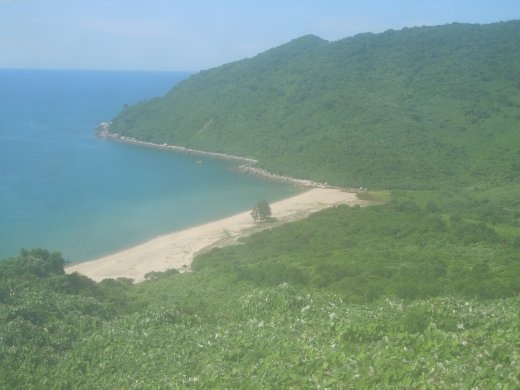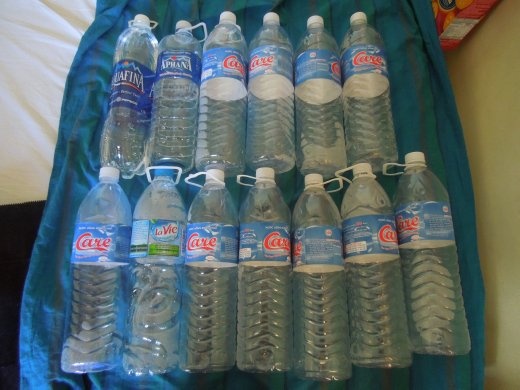After a wonderful week in Hoi An, we headed up to the nearby port city of Da Nang to catch a train further north to the ancient capital city of Hue (pronounced "Hway"). The views from the train were unbelievable- this is said to be the most beautiful train ride in all of Vietnam, and it certainly lived up to the hype. We hugged the coastline, darting in and out of tunnels blasted through the rocks high above the sea below. Unfortunately these views were the only good part of this train experience. We'd gotten to the train station about an hour early, just to be safe, where we discovered the train was running late. It was a HOT day out and the train station was not air-conditioned and packed full of people and luggage. There was nowhere to sit, only candy and cookies to eat, and nothing was in English so we had no way of knowing which was our train or when it was coming. This meant we couldn't leave the station for fear of missing our train. It ended up being over 3 hours late (so we sat in this oppressive heat with no food and little water for over 4 hours). When we got on the train, things weren't much better. Although we'd paid extra for the "1st class air conditioned" car there was definitely no air at all. People packed even the aisles, fanning themselves with whatever they could find and the sun streamed in through the windows. The train sat on the platform for another 45 minutes before even moving, and then it only went about 100 feet before stopping and sitting for another hour. It was like being stuck in a hot metal sardine can. We'd run out of water by this time and just sat there, helplessly drenched in sweat, trying not to pass out. It had taken us 5 hours to get 100 feet outside of town... and this entire train ride was only supposed to take 2 hours total!
 The only good part of the train ride: Views of the Vietnamese coastline
The only good part of the train ride: Views of the Vietnamese coastline
Understandably, we were not in the best of moods when we finally pulled into the Hue train station. To top it off, we had no map of Hue, and therefore no way of knowing where on earth we were in relation to the city or any hotels! (This happened to us a LOT on this trip, but we weren't usually so miserable as we were now). We were immediately surrounded by taxi drivers shouting "Where you want to go!?" at us as we exited the station, and for anyone that has ever experienced this type of salesmanship... well it is a bit stressful and off-putting. We have also gotten more used to this approach, but for now we were tired, sweaty, overwhelmed, and Sarah was feeling faint. However the desire to not be "taken" by a local driver was still driving us so we found a map and decided it didn't look like too far of a walk to the backpackers district of the city. We were wrong. After about 45 minutes of walking with our giant packs on our backs (very full now thanks to all those clothes we'd picked up in Hoi An) we almost gave up and hailed a cab. Luckily though, we looked ahead and saw the street we had been looking for was dead ahead. We made it into the nearest bar, collapsed at a table and ordered the biggest bottled waters they had. We'd made it to Hue, but this was just the start of our troubles here.
Later that night, after finding and checking into a cheap little hotel (at least it had aircon!) Joe was ready to go out and explore the town. Sarah wasn't feeling so well after such a trying day, so she decided to stay in and rest. By the time Joe returned later that night, Sarah was worse. Much worse. She had a fever and chills, was sore, stiff, and weak all over, and was having a lot of pain and trouble breathing... not good. We spent the next 4 days in that cramped little hotel room while Sarah fought off this flu bug. (We decided later it was a flu bug but at the time we were very worried it was meningitis). She was too weak to get out of bed so Joe went out each day to buy water and food to bring back to her. He found a pharmacy and brought her medicine as well. When her fever spiked to 103, we debated cashing in on our traveller's insurance to have her taken to a hospital in Bangkok (there were none recommended for foreigners in this part of Vietnam). We agreed if she was still sick the next day we would do this. Thankfully, she woke up feeling better and the worst was past. Looking back, we've decided that an experience like this can make or break a couple. Being cramped up together in a tiny little hotel room for 5 days while one person is sick and cranky and the other is worried and cranky is not something everyone can handle. However we made it through! Sarah is still thankful for all of Joe's help and care, and Joe is thankful that we'll hopefully never go through something like this again!
 Just some of the waters Sarah drank while sick-- each of these is twice the size of a normal water bottle.
Just some of the waters Sarah drank while sick-- each of these is twice the size of a normal water bottle.
We had only planned to spend 2-3 days total in Hue. We were now on day 5. We hadn't seen a single thing here and Sarah was still very weak. However we decided to try to make the best of it by visiting the #1 tourist site in town- the ancient citadel. We definitely took taxis this time. As we drove through the city we saw that it is very pretty, if not quite as charming as Hoi An. The Perfume River runs through the town and they have a beautiful park-lined riverfront. As the capital of the Nguyen dynasty from 1802-1945, Hue was a major cultural, economic, and political center for Vietnam. After 1945 Vietnam splintered and new capitals were established- in Ha Noi for the North, and Saigon for the South. Unfortunately, Hue was the site of major action during the Vietnam War (or "War of American Aggression" as they call it here). Because of its central location just south of the Demilitarized Zone (or DMZ), it was a central focus point during the 1968 Tet Offensive and is known for both the Battle of Hue and the Massacre at Hue. The city was basically bombed to smithereens, including the citadel and all of the ancient buildings within it, which were located right at the center of town. After the war, Hue's historic buildings and sites were neglected by the Communist government because they were seen as "relics from the feudal regime" and not worth saving. Today the Vietnamese have a slightly different view and many of the city's historical areas are being restored. We saw a lot of workers on the grounds of the Citadel and a lot of construction. It was still very hot out so Sarah had to take frequent water/rest breaks and we didn't tour as much of the grounds as we would have liked. However, to be honest, there still isn't much to see besides the foundations of what used to be buildings before they were destroyed. It would be like walking around Beijing's Forbidden City, except without any buildings, just open fields.

Joe in front of the Hue Citadel entrance
We did manage to squeeze in one more site after the Citadel-- the famous Thien Mu pagoda. Hue is known for its beautiful pagodas and temples lining the Perfume River and this is one of the more famous/beautiful ones. It's set atop a quiet hillside with pine trees and gardens and a Buddhist temple. It was very tranquil. The pagoda was founded in 1601 and the central octagonal tower was built in 1844. This tower is considered Hue's unofficial city symbol. Around the tower are an 8 foot high stone stele on the back of a giant marble turtle carved in 1715 and a giant bronze bell that weights almost 6,000 pounds! Apparently when it rings people can hear it up to 6 miles away.

The tower of the Thien Mu Pagoda